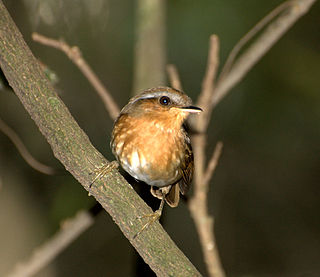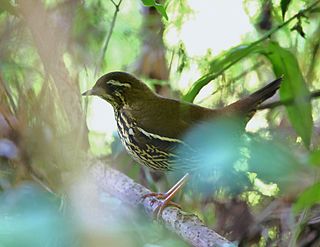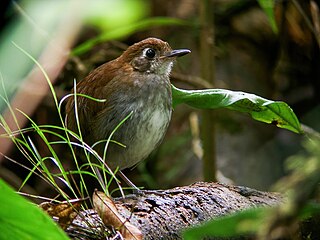
The rufous gnateater is a passerine bird of the gnateater family, Conopophagidae. It is found in forest understory and bushes in eastern Brazil from Rio Grande do Sul north to central Brazil. Its range also extends into eastern Paraguay and north-eastern Argentina and it has recently been recorded in Uruguay. It is often elusive and hard to see, but is commoner and less shy than other gnateaters.

The hyacinth visorbearer is a species of hummingbird in the family Trochilidae. It is endemic to Brazil.

The rufous-tailed antthrush or Brazilian antthrush is a species of bird in the family Formicariidae. It is found in Argentina and Brazil.

The slaty gnateater is a species of bird in the family Conopophagidae. It is found in Bolivia and Peru.

The chestnut-belted gnateater is a species of bird in the family Conopophagidae, the gnateaters. It is found in the Amazon Basin of northern Brazil, southern Colombia and eastern Peru and Ecuador; also the Guianan countries of Guyana, Suriname and eastern French Guiana. Its natural habitat is tropical moist lowland forest.

The chestnut-crowned gnateater is a species of bird in the family Conopophagidae. It is found in Colombia, Ecuador, and Peru.

The black-bellied gnateater is a species of bird in the family Conopophagidae. It is endemic to Brazil.

The black-cheeked gnateater is a species of bird in the family Conopophagidae endemic to Brazil. The male is distinguished by its orange crown, black face and white throat, while the female has brown plumage.

The ash-throated gnateater is a species of bird in the family Conopophagidae. It is found in Bolivia, Brazil, Ecuador, and Peru.

The southern antpipit is a species of bird in the family Tyrannidae, the tyrant flycatchers. It is found Argentina, Bolivia, Brazil, and Paraguay.

The ringed antpipit is a species of bird in the family Tyrannidae, the tyrant flycatchers. It is found in every mainland South American country except Argentina, Chile, Paraguay, and Uruguay.

The black-hooded antwren is an Endangered Species of bird in subfamily Thamnophilinae of family Thamnophilidae, the "typical antbirds". It is endemic to Brazil.

Watkins's antpitta is a Near Threatened species of bird in the family Grallariidae. It is found in Ecuador and Peru.

The hooded antpitta is a Near Threatened species of bird in the family Grallariidae. It is found in Colombia and Venezuela.

The crescent-faced antpitta is a species of bird in the family Grallariidae. It is found in Colombia and Ecuador.

The Peruvian antpitta is a Near Threatened species of bird in the family Grallariidae. It is found in Ecuador and Peru.

The masked antpitta is a Vulnerable species of bird in the family Grallariidae. It is endemic to Bolivia.

The grey-hooded flycatcher is a species of bird in the family Tyrannidae, the tyrant flycatchers. It is found in Argentina, Brazil, and Paraguay.

The tepui antpitta or brown-breasted antpitta is a species of bird in the family Grallariidae. It is found in Brazil, Guyana, and Venezuela.

The Ceará gnateater or Caatinga gnateater is a passerine bird of the gnateater family, Conopophagidae. It is found in forest understory and bushes in northeastern Brazil.






















